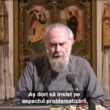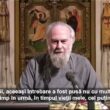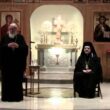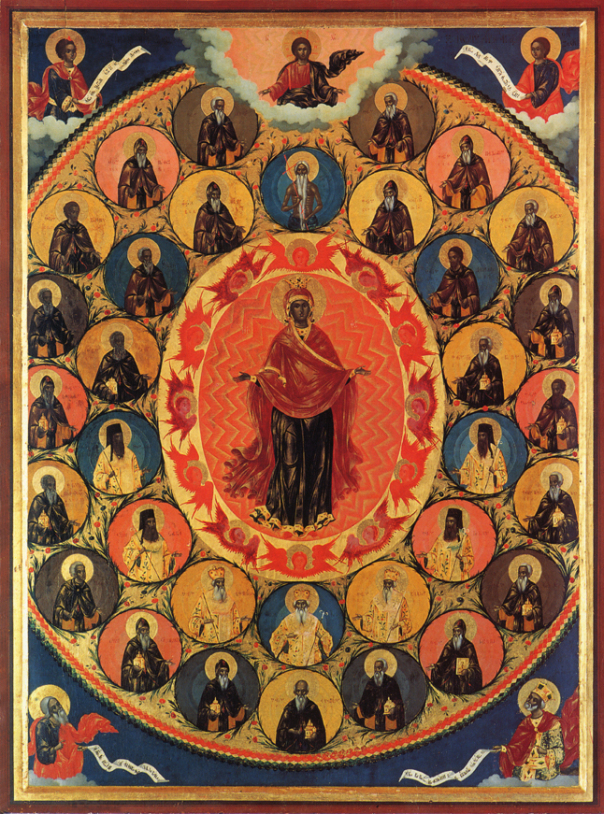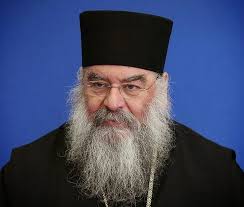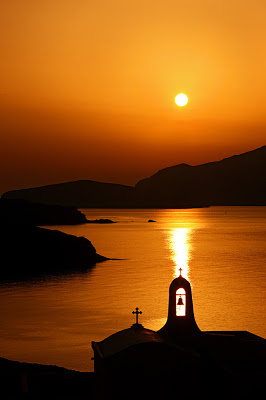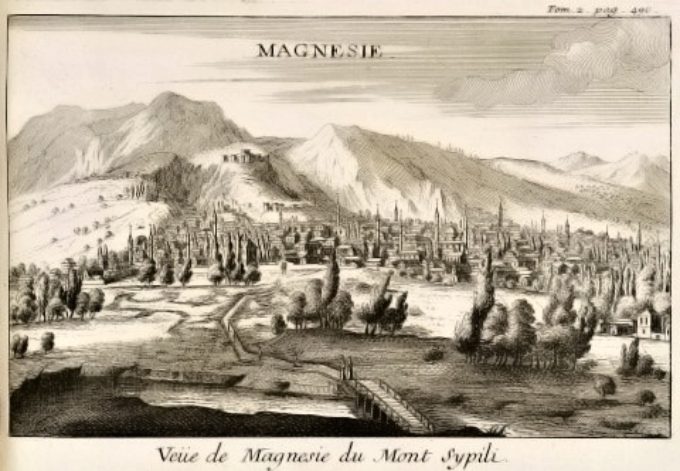If it is true that there are places in the world of such a beauty and irradiance that they can infuse man with enthusiasm and veneration and can lead him to spiritual revival, then certainly the Holy Mountain holds a prominent position among them.
The Holy Mountain is embellished of course with all the beauties of nature that the grace of God generously bestowed upon it like on another heaven. It is also adorned with the beautiful holy monasteries and hermitages with their gorgeous architecture, perfectly adapted to the natural environment and with very precious holy relics and other religious objects that are treasured here. All these embellish it making it look like another heaven with their splendor.
Even more than with these, the Garden of the Theotokos – this is how the faithful Greek people call the Holy Mountain – is proud, exults, is enlightened and is honored by the virtuous men and saints who practiced asceticism there in different times. For its saints! Because since the early years of the Athonite history, ascetics, wonderful holy fathers shone in this place with the help of God and the protection of the Holy Virgin and their memory is eternal. All these blessed men, like other athletes, spent their life here, in uncountable labors and hardships and having this Holy Mountain as a ladder they rose to heaven.
The vivid presence of the Mother of God who is the protector of the Holy Mountain and the ascetic struggles of the remarkable holy men make of each part of Athos a place of theophany. The modern pilgrim who travels in the Holy Mountain and gets acquainted with the place and its history feels this thing and senses the presence of God at each step he takes.
At this point I would like to thank the organizers of today’s event which takes place within Philokalia, the international festival of sacred art. I thank them for the opportunity they offered me to come here from the remote Athos bringing on the blessed land of Romania the blessing of the Mother of God and the Athonite fathers and to speak to such a distinguished and philocalic public. I hope – with the prayers of the reverent fathers – this conference would become an useful companion in this spiritual search of each one of us.
The communal monasteries, the hermitages, the recluse cells, the huts, the graveyards, caves and places of ascesis that hang in remote and inaccessible places are quiet witnesses of the blessed, angelic lives of the pious Athonite elders and for us, the young ones, monks and worshippers a permanent invitation to follow their example.
In the Holy Mountain more than four hundred saints lived from the IXth century until today. There are of course many other saints unknown to us who pleased God and were honored by Him. The Holy Mountain is maybe the only place in the world where nobody was born but it was and by the help of the divine grace still remains a place where thousands of people were reborn in Christ.
The Saints of our Church may be purposefully honored in a certain place but they belong to the pleroma of the entire Church.
And we know very well that on the Orthodox land of Romania many Athonite saints are extremely honored by the believers.
What Romanian doesn’t know about saint Athanasios the Athonite, saint Gregory Palamas, saint Niphon, the patriarch of Constantinople, saint Nicodemus the Athonite? Who did not benefit of the wisdom and teaching of our contemporary saints, elder Paisios the Athonite and elder Porphyrios the Kavsokalivite? Or who’s the Romanian that doesn’t know about saint Paisios Velicicovski (+1794) who after spending a part of his life in the Holy Mountain lived in Romania, in Iasi and in the monasteries Neamt and Dragomirna bringing here the spirit of the Athonite monarchism and of the Philokalia.
Saint Paisios and his disciples made for the Romanian people elaborated translations of the Greek fathers of the Church. It is significant the fact that only after ten years from the publication of the first edition of Philokalia in Greek in 1793, we have its first translation in Slavonic, language in which were written then the religious texts in Romania.This work was republished several times and aroused a high interest for the hermit fathers of the Church in Romania and other Balkanic countries.
In accordance with the sources, we have Romanian monachal presence in the Holy Mountain even from the XIth century. From the fall of the Byzantine Empire and afterwards rulers from Valachia, knowing the spiritual benefit your country would get from the contact with the Holy Mountain, offered many gifts, consecrated metochions and proved to be founders of many Athonite monasteries, contributing to their restoration. At the same time, Hariton (+1381) one of the first metropolitans of Valachia, who established the groundwork for the organization of the Romanian church was Athonite.
One of the most honored Athonite saints in Romania is saint Nicodemus the Hesychast, of Greek-Serbian descent, founder of Tismana monastery. St. Nicodemus came in Valachia from the Holy Mountain around 1360. He was a transmitter of holy irradiance and contributed to the revival of monarchism in the Romanian countries for he with the help of his disciples founded and organized in Romania monasteries after the model and order from the Holy Mountain. Tismana monastery is the oldest monastery that was preserved in Romania and it became among others a famous centre for calligraphy and replication of manuscripts.
Ending this brief paranthesis referring at the Athonite saints who are in close relation with your blessed country and who left a valuable and everlasting legacy and who continue to pray for us all, we shall refer at saint Niphon the IInd, the patriarch of Constantinople (+1508), this illustrious illuminator of the Romanian land. Saint Niphon, Athonite monk from Dionisiou Monastery contributed decisively at the reorganization of the Romanian Church and at the defense of Orthodoxy, while giving a new impetus to the spiritual life. A part of his holy relics are kept at Curtea de Arges, where thousands of believers come every year for honoring his memory.
Ultimately the spiritual benefit gained by the Romanian people from the work of the Romanian Athonite saints Gheorghe from Cernica (+1806), Antipa from Caldarusani (+1882) and the new martyr Pachomius (+1810) was great.
My beloved brothers in Christ!
The Athonite saints coming from all Orthodox peoples devoted themselves completely to God.
By means of their various ascetic struggles, they purified themselves of passions and became noble vessels, worthy to receive the divine charisms. And afterwards they became brilliant successors of the true Orthodox monastic tradition.
At the end of the XVIIIth century st.Nicodemus the Athonite, that was the first who wrote the Holy service of the Athonite saints as well as the word of praise about them remark that the Athonite saints have shown themselves to all of us who live in the Holy Mountain but also to all the Orthodox people, permanent benefactors, defenders and guardians not only by their words but also by their deeds. Not only with their soul, but also with their body, not just while being alive on earth, but also after their death.
The Holy Mountain was named so from its saints. According to st. Nicodemus the Athonite the Holy Mountain means ”place of holiness, place of purity.” Place that was treaded by so many holy feet. Place where the ground was watered by the blood, ascetic sweat and tears of the hundreds and thousands of pious elders. The Holy Mountain is a place of virtue and holiness.
The way to apotheosis, the cultivation of the Orthodox spirituality and its acquisition through ascetic struggles represented and continues to represent, with the grace of God, the strongest support of life on the Holy Mountain.
In this land of repentance and laboratory of godliness countless saints, videlicet friends of God, who illuminate with the sweet rays of their lives and miracles the crowd of the believers, were led over the centuries on the paths of salvation.
According to the Orthodox tradition the best suited for talking about saints and holiness are the saints themselves. They can understand and interpret correctly in the light of their own experience of sanctity, the deeds and teachings of those holy persons who had as main aim they accomplished – to please God and unite with Him.
My humble self who does not have their holiness and spiritual feeling and who, by the grace of the Lord and the maternal love of the Holy Mother of God, lives in the same holy places with hallowed Athonite persons, can only outline broadly, by reflection and guess, some of the rich charisms – fruits of their ascetic struggles and of their bright teachings. As elder Porphyrios the Kavsokalivite, one of the latest personalities from the golden chain of pious Athonites, said: ”Indeed these must be experienced by man for understanding them…Only the one who experiences this state, lives it and feels it.”
The motivation of the Athonite hermits to subject their bodies willingly to tribulations and different privations is not hate against flesh and material life, but the richer life that springs out of Christ’s love, when this works and lights up the heart. They wished to crucify themselves for the world and to kill their passions completely, to bury themselves in the tomb of humbleness and to revive with Christ through passionlessness.
With their bodies they worked and served their brothers and with their mind and heart talked ceaselessly with God, through prayer. Ravished in ecstasies and contemplations of the glory of God, they foretasted here the relishes that should delight those who love God.
On the Holy Mountain is preserved the uncreated flame of the church life. And the holy Athonite personalities represent one of the manifestations of this pure, divine light and another testimony of the divine grace: of the Athonite life and experience nowadays.
These heroes of volition have set faith as steadfast foundation of their salvation. Everything, from their divine experiences full of grace to their revealing foresights and prophecies as well as their pious teachings, testifies the permanent presence of the Holy Spirit in these holy personalities of the Athonite elders, who wrote by their lives a new Patericon, proving the truth, the actuality of the stories and descriptions from Sinaxars.
They by living in the holy cloud of God themselves, were able to lead others to the heavenly Jerusalem, to teach them the mental prayer, to offer them guidance in spiritual life, to strengthen them in trials and temptations. Many of these enhanced elders helped not only a lot of Athonite monks with whom they lived, but also the people of God, transmitting them the ethos of the Athonite spirituality and showing them the freedom of the age to come.
Through their word full of divine experience, they touched the thirsty souls, they united the enlightened word with vivid feeling and transferred theology from the sphere of thought in that of personal life. They inspired in faith countless people, otherwise lost. They soothed hopeless souls, they enlightened with their wisdom and grace the crowd of truth seekers. Others, like the blessed elder Porphyrios the Kavsokalivite spread from their own inner self the light and joy of Resurrection they experienced and received from the Athonite life and praxis. They gained powers from the inexhaustible Athonite springs for a few years and transformed themselves in universal reformers of the spiritual life in Christ.
The Athonite enhanced elders of the past century continued the bimillenary tradition of the Holy Mountain and they set themselves in the golden chain of the pious fathers.Actually the Athonite time may be contemporary only with eternity.
The truly impressive personality so rich in charisms of our elder Porphyrios the Kavsokalivite was cultivated in a place where spiritual tradition remained alive till nowadays. From the first dwellers of the old Athos till the latest enhanced elders, they all make a spiritual family, where everything is in common: the ascetic thought, the spiritual accomplishments and charisms. Actually the feeling of historical continuity of the Athonite tradition represents the cornerstone for the spiritual itinerary of the Holy Mountain.
On the other hand from the life of the contemporary Athonite elders emerges the continuity of the Athonite tradition. These hermits with the authenticity of their simplicity and of their ascetic life permanently restate the mystery of faith and testify the presence of God in our world, confirming the possibility we all have to be in communion with God and to share eternity. The life of many people who knew saints and other enhanced Athonite elders and were in contact with them, changed radically, for their presence was determined and sealed their existence. The Athonite saints and other holy personalities of the Holy Mountain were true spiritual fathers, reached a high spiritual level and for this reason they could act as teachers and counselors in family matters, in a certain way.
The pedagogy they applied, based on the ministry of spiritual fatherhood was no other than the pedagogy of the church fathers, which is preserved till nowadays, through the hesychast and philocalic tradition of our Church.
According to saint Simeon the New Theologian, the spiritual father is the vivid presence of Christ. He is the perfect one, the man reborn in Christ. He is a reverberator of the divine light in our world. We could say that he is the absolute teacher. Such models of teachers, of advisers for the youth and old people as well, through their word, were and continue to be, by the grace of God, the Athonite saints and other holy Athonite personalities. Men of complete love, of sacrificial love, of inner spiritual perfection and of holiness.
Saint Athanasios the Athonite is considered the founder of the Athonite monasticism from the building of the Great Lavra (year 963). The following fact expresses the ascetic character of saint Athanasios’pedagogy.
Once the demons urged an idle monk to kill the saint. And that man got out heading for the starets’cell with the knife in his hand. When he opened his door and the saint embraced him friendly then the ungrateful disciple, with killing thoughts, let the knife fall down from his hand, knelt down and confessed his intention. Saint Athanasios forgave him immediately. And didn’t stop just at this, but from that moment he showed even more love to that monk. The voluntary humility is a mark of the authentic life in Christ and spring of immortality. The pious freed of his own self, deepening in the bottomless divine grace from where he gained love for his potential killer. In the effort of becoming a model for his disciples, saint Athanasios took care of the needs of all the monks from his monastery and especially of the sick ones, whom he personally served.
By spiritual guidance, namely in a mystagogical and spiritual way, the holy personalities of Athos contributed at their own birth and rebirth being in contact with these spiritual fathers.
They did not teach proposing abstract moral rules. They mainly guided the others within a very close personal relationship. They loved man right as he was, with his weaknesses and flaws. In the same time they acted with pedagogical caution and with psychological vision, using flexible pedagogical methods.
They taught not only by their word, but by their silence as well and very often by their simple presence. For instance, in the Life of the pious Acacius the Kavsokalivite (+1730), a great Athonite saint of the XVIIIth century is told that among his numerous charisms, he had a pacifying spirit in such a degree that even those who were possessed by revengeful thoughts when they saw him, his face so full of grace calmed their evil thoughts.
Remembering in all these years the honored person of elder Paisios the Athonite (+1994) and his bright counsels and teachings that were dripping balm in the hearts of all who had more or less the blessing to meet him, I got the feeling that everything he suffered patiently in his ascetic life, meaning: privations, pains, temptations, exhausting travels, derangements and fatigue from the countless pilgrims and in the end terrible illnesses, he all suffered out of love for God and man. And in the monasteries where he served, inside and outside the Holy Mountain and while he lived in solitude, his life was a continuous ministration of love. A boundless love, so sincere and resulting from the deification of his soul that soothed all who tasted it. Even in the period before his pious end, though cause of his terrible illness, had excruciating pains, he sacrificing himself for his brothers, served with self-denial and self-sacrifice all those who ran to him for help.
In his rich teaching which refers in detail at all the themes of life in Christ and which awakens us spiritually, we see the elder talking with pain and love about us all.
From the pantheon of virtues, love – distinct among the others – seems to enliven the entire life and teaching of elder Paisios. He told his listeners, emphasizing the power of love: ”For we do not know what awaits us, cultivate love as much as you can. This is the most important thing of all: to have among yourselves true, brotherly love, not false love. Every time when there is good concern, compassion, love, things are done right. Kindness and love mean power.”
One of the best ways to express our love is to pray for others. This truth and its value are highlighted by the elder: ”The prayer uttered from the heart helps not only the others but ourselves as well, for it supports the apparition of inner kindness. When we try to walk in someone else’s shoes love, pain, humility, gratefulness for God with ceaseless doxology come out naturally and then our prayer for our neighbor is welcomed by God and helps him.
At the question about the way in which he understood when someone else got a benefit from his prayer, he answered: ”He is announced by the divine comfort he feels inside after the painful heartly prayer he had made. But first you should make from the pain of the other your own pain and then pray from the heart. Love is a divine virtue and announces you.” Love is the condition for reaching the aimed result from searching the mistakes of the other and this fact is highlighted by elder Paisios: ”When we explore someone out of love, either he becomes aware of our love or not, a change takes place in his heart, for we are driven by pure love. While the search made without love and empathy makes a beast of the other one, for our malice strikes his selfishness. When we tolerate the other out of love, he feels it.”
Sacrifice for our brother is imitation of Christ. ”Learn to rejoice when you give to others”, the blessed father said and stated as follows: ”These people who give themselves without taking themselves into account will judge us after tomorrow.”
Christ himself is moved when we love our brother more than we love ourselves and fills us with divine joy. You see the One who did not limit himself to the syntagma ” love your neighbor the way you love yourself”, but sacrificed himself for man. And he adds: ”It is not possible for the love of Christ to come inside ourselves if we do not eliminate our self from our love and we do not offer ourselves to God and to our brothers, without expecting to get anything in return from the others. Insisting upon the sacrificing self-abnegation as an expression of perfect love the elder advices us: ”The sacrifice for our brother implies to have a great love for Christ. All those who have the disponibility for being generous but do not have anything and suffer from this reason, give alms with the blood of their hearts.” And for strengthening those who cultivate the empress of virtues, he adds: ”The generous ones, for they always feed the others with love, are always fed by the love of God and his plentiful blessings.”
One of the contemporary Athonite elders who was one of the most significant spiritual presences of the past century is the elder Porphyrios the Kavsokalivite (+1991), already known in the entire Orthodox world. We witness an extraordinary phenomenon of divine life and call.
He remained in the memory of people as a spiritual confessor full of discernment. In this way he could help in various ways, by various means. He considered each man as an unique and unrepeatable personality, respecting everyone’s distinct features as well as their personal freedom. He listened carefully, patiently, with condescension their problems. He became receiver of their troubles. He answered kindly to their various questions. He adviced and supported the weak ones. He did not get upset because of the annoying presence of certain spiritual sons or because of their indiscretions and exasperating attitudes.
He accepted his fellow just as he was, with his weaknesses and the peculiarities of his behaviour. He never tried to make them be imitations of himself. He was not interested in the exterior look of people, especially of the young ones.
He looked deep inside their souls for he knew that if it was made order in their inner world, the exterior aspects would be put in order as well. Because he knew about the tragedy of nowadays regarding the lack of love which causes loneliness, sadness, insecurity, stress and fears.
Elder Porphyrios said: ”What you want to tell your children say it in your prayers. The children do not listen with their ears. Only when the divine grace comes and enlightens them they listen to what we want to tell them. When you want to tell something to your children, tell it to Virgin Mary and she will work. This prayer of yours will become a strong blow, a spiritual comfort that will sooth, embrace and draw the children near.”
My beloved brothers in Christ!
The high spiritual life of the Athonite elders, always incentive, vivid and full of vigor breaks the weir of time, surpasses the unabated historical storms and the human ventures for echoing as a spiritual alarm for the restless, blurry and noisy present.
Contemporary man dominated by the digital technology and the scientific discoveries of historical importance learnt how to handle the machines, but did not learn how to handle himself. He does not succeed to live uninfluenced by the dissolving syndromes which enslave the entire creation. He is smashed by huge ideologies.
The sanctified path crossed by the Athonite saints and enhanced elders for meeting Christ may enlighten our future and inspire us to fill our lives with the ”good fight” in the ”trenches” of the divine grace, which is the insatiable love, as saint Silouan the Athonite says.
The way and the modality for the deification and salvation of man is eternal and safe: is the path of the saints! The sanctified Athonite personalities of the past and of nowadays, from the pious Peter the Athonite, the first inhabitant of Athos till our contemporary elders Paisios the Athonite and Porphyrios the Kavsokalivite, reached the beloved place where we were all called to live.
And because we are facing hard times when the economic crisis mills our society I’d like to end with an optimistic message, I’d like to believe is addressed to my listeners.
As Dostoievski said: ”beauty will save the world.” The beauty of soul will save the world, even if around us everything seems to fall apart in our times. But we must not lose our courage. We should get back into our soul for uniting it with God and from inside this unity and concentration we would be able, by the help of God, to cross safely the stormy sea of our life.
Thank you very much! Christ is risen!
Lecture held at Arad, on May 25, 2013, with the occasion of the festival Philokalia.
Source: pemptousia.ro

